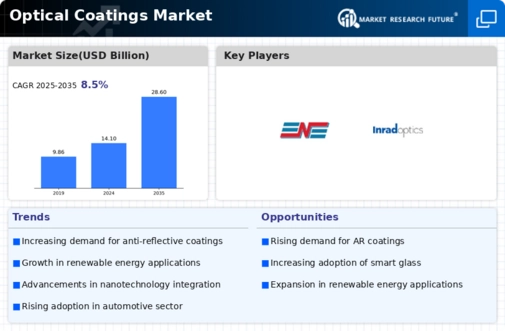Market Trends
Key Emerging Trends in the Optical Coatings Market
The path and direction taken by the optical coating sector are being shaped by significant trends that have impacted the entire industry outlook. One notable trend is the increasing demand for anti-reflective coatings across multiple applications. As consumers look for better performance optics in eyewear products, cameras, and display devices, among others, manufacturers are incorporating advanced anti-reflective coatings into their designs accordingly. In addition, there has been an increase in the use of optical coatings in the solar energy industry. Solar panels have become focal points for a global shift towards sustainability because of increased emphasis on renewable sources of energy. Optical coatings have a great effect on solar panels as they minimize reflection while maximizing light absorption, thus improving their efficiency, which is part of this particular development. It comes out very clearly from this trend that optical coatings play an important role when it comes to challenges related to energy generation and conservation. The second remarkable trend within the market for optic coating is environmentally friendly coatings gaining popularity among stakeholders, including manufacturers and consumers alike worldwide at large. large.No. No wonder, then, that producers are putting money into research and development (R&D) with a view to manufacturing environmentally benign coatings. Such water-based or solvent-free alternatives are coming up as substitutes for traditional organic compounds containing optically coated materials. Moreover nanotechnology advancements have facilitated change within such sectors. Nanocoatings possess attributes such as greater durability, enhanced scratch resistance, and better adhesion than ordinary optical treatments. As a result, these innovations make the production of modern optical systems that last longer and have better quality possible. Meanwhile, nanotechnology applied in optical coatings is opening up the field for new applications, such as electronics, aerospace, and health care. There is also an increasing preference for smart, responsive coatings in the market. Smart optic coatings can change their properties if required when environmental conditions change, such as temperature or light intensity, thereby giving room for dynamic operations. This trend can be observed particularly in the automotive industry, where smart coatings are utilized for self-cleaning surfaces, anti-fogging surfaces, and windshields with less glare, among others. The Asia-Pacific region has become the main growth area for the optical coating sector due to geographical shifts in demand patterns. From consumer electronics to industrial machinery, there is a growing use of optical coatings in this region courtesy of its strong manufacturing base coupled with a rising consumer population. Such changing trends have led manufacturers to strategically expand their operations within Asia-Pacific regions so as to tap into emerging opportunities.





Leave a Comment